Nikon AF-S DX NIKKOR 18-200mm f/3.5-5.6 G ED VR II Lens
Nikon AF-S DX 18-200mm f/3.5-5.6 G ED VR Performance
At 18mm sharpness is already excellent in the centre portion of the image at maximum aperture, with good clarity towards the edges of the frame. Stopping the lens down to f/8 results in excellent clarity across the frame at this focal length.As is the case with many super-zoom lenses, sharpness deteriorates as the lens is zoomed in for a given aperture. At 70mm sharpness is still good at maximum aperture, improving to excellent levels with the elns stopped down to f/11.
At 200mm clarity at maximum aperture is just short of good levels in the centre, with fair sharpness towards the edges of the frame. Stopping down improves sharpness in the centre to very good levels between f/8 and f/11, but the quality towards the edges still lags behind somewhat.
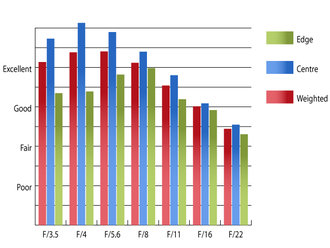 Resolution at 18mm | 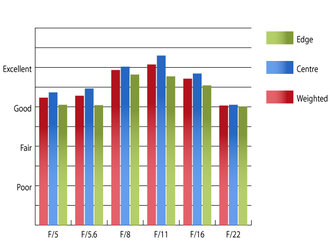 Resolution at 70mm | |
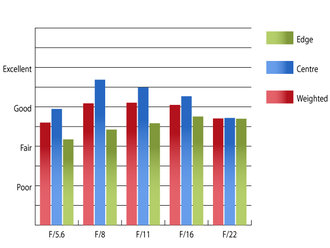 Resolution at 200mm | How to read our chartsThe blue column represents readings from the centre of the picture frame at the various apertures and the green is from the edges. Averaging them out gives the red weighted column.The scale on the left side is an indication of actual image resolution. The taller the column, the better the lens performance. Simple. For this review, the lens was tested on a Nikon D300 using Imatest. |
Chromatic aberrations are well controlled, especially for a lens covering sucha wide range of focal lengths. At their worst CA can cover an area a shade over 0.75 pixel widths, which should pose few issues.
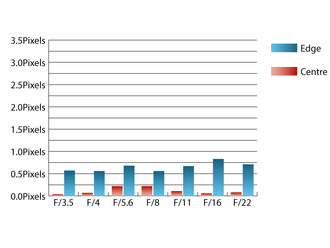 Chromatic aberration at 18mm | 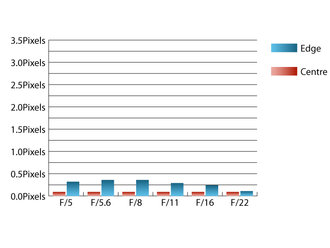 Chromatic aberration at 70mm | |
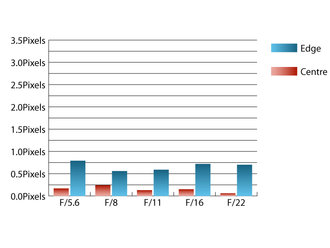 Chromatic aberration at 200mm | How to read our chartsChromatic aberration is the lens' inability to focus on the sensor or film all colours of visible light at the same point. Severe chromatic aberration gives a noticeable fringing or a halo effect around sharp edges within the picture. It can be cured in software.Apochromatic lenses have special lens elements (aspheric, extra-low dispersion etc) to minimize the problem, hence they usually cost more. For this review, the lens was tested on a Nikon D300 using Imatest. |
Falloff of illumination towards the corners is well controlled. At f/3.5 and 18mm the corners are only 1/36 stops darker than the image centre and visually uniform illumination is achieved at f/5.6. At 200mm the corners are only 0.75 stops darker than the image centre at maximum aperture and visually uniform illumination is attained at f/8.
Distortion is often a weak area with super-zoom lenses. Although barrel distortion of 3.93% can be detected by Imatest at 18mm, this level is reasonable when compared to other lenses covering a similar range. Pincushion distortion levels of 1.34% at the telephoto end aren't overly disturbing either. If perfecetly straight lines are required, the distortion present should be relatively easy to correct in image editing software as the distortion pattern is uniform across the frame.
Add your message
Login required
Please login here or if you've not registered, you can register here. Registering is safe, quick and free.
Please login here or if you've not registered, you can register here. Registering is safe, quick and free.
photodo Stats
1102 lenses
428 MTF tests
74 in-depth photodo reviews
100+ users join each day
Help the lens community by reviewing or rating a lens today via our lens search
428 MTF tests
74 in-depth photodo reviews
100+ users join each day
Help the lens community by reviewing or rating a lens today via our lens search
Latest Lens Reviews
- Chinon 28mm f/2.8 Vintage Lens Review
- Canon EF 70-200mm f/4L IS II USM Lens Review
- Samyang AF 85mm f/1.4 EF Review
- Sigma 70mm f/2.8 DG Macro Art Review
- Samyang AF 24mm f/2.8 FE Review
- Meike 50mm f/1.7 Review
- Tamron 70-210mm f/4 Di VC USD Review
- Lensbaby Burnside 35mm f/2.8 Review
- Asahi Super Takumar 50mm f/1.4 Review
- Asahi Super-Multi-Coated Takumar 135mm f/3.5 Review
